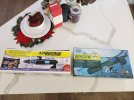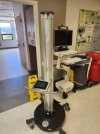Ditto what was said above. UV is highly corrosive and will break plastic down over time. The cheapo ones will only last for so long so they're better for specific treatment rather than 24/7/365 use. On my old 50g tank, the green machine didn't do squat against dinos, but a 15w AquaUV with a properly sized pump eradicated them. I like that the higher end units have published flow rates to exposure (microwatts per square centimeter, µW/cm2) so you can dial it in and be effective against what you're targeting.
You are using an out of date browser. It may not display this or other websites correctly.
You should upgrade or use an alternative browser.
You should upgrade or use an alternative browser.
UV Sterilizer
- Thread starter Matthew Meyer
- Start date
Matthew Meyer
Supporting Member
Matthew Meyer
Supporting Member
Currently testing in sump from input side to refugium.
Last edited:
For dinos I'd recommend placing the feed pump straight in your tank in a high flow area, and hanging the UV there. You're trying to capture all the dinos as they become free swimming at night. If the UV is in the sump, you're depending on them going all the way to the surface into the overflow.
Matthew Meyer
Supporting Member
Hmm. Ok, ill move it to the display for a few days, i was hoping for a more permanent implementation thoughFor dinos I'd recommend placing the feed pump straight in your tank in a high flow area, and hanging the UV there. You're trying to capture all the dinos as they become free swimming at night. If the UV is in the sump, you're depending on them going all the way to the surface into the overflow.
Pm me your email. I can send you a guide on dinos. You'll need a microscope to identify what type you have to find proper treatment to get rid of them. General tips, keep nitrate and phos up, UV inlet placed close to the sand bed (2-3x display tank volume flow) and dose a lot of pods.Hmm. Ok, ill move it to the display for a few days, i was hoping for a more permanent implementation though
Matthew Meyer
Supporting Member
Interesting video. Got though part of it-need to watch the rest later.After the dino population is pushed back then the sump is ok for maintenance mode. For right now, u want to kill them faster than they can multiply.
Good brstv video on the importance of uv flow/turnover rate
Curious how many people use them
Matthew Meyer
Supporting Member
For dinos I'd recommend placing the feed pump straight in your tank in a high flow area, and hanging the UV there. You're trying to capture all the dinos as they become free swimming at night. If the UV is in the sump, you're depending on them going all the way to the surface into the overflow.
Attachments
I am part of the mack's reef group on FB that a lot of this info tends to come from. I think there's good stuff in there, like the dino id guide, and then tons of garbage info regurgitated over and over. It's much more cult than science.
I think the display vs sump thing is one of those bits of pseudoscience personally. With a high amount of flow in a reef tank, and a large amount of water turnover through the sump, the in display pump doesn't seem like it's going to have access to more dinos than the sump. As an example, imagine some good dropped in your tank, even pushed out near the bottom, are the odds higher it's going to get pulled into the UV or the overflow?
The justifications that I do think are plausible:
I think the display vs sump thing is one of those bits of pseudoscience personally. With a high amount of flow in a reef tank, and a large amount of water turnover through the sump, the in display pump doesn't seem like it's going to have access to more dinos than the sump. As an example, imagine some good dropped in your tank, even pushed out near the bottom, are the odds higher it's going to get pulled into the UV or the overflow?
The justifications that I do think are plausible:
- That using a separate pump vs plumbed into your return helps -- this seems reasonable because you can control the flow well
- That lower flow through the uv are good -- I'm willing to believe dinos could require higher irradiation
- That people with very low tank flow could be helped by an extra pump in their display -- I doubt that's people here
I think the display vs sump thing is one of those bits of pseudoscience personally. With a high amount of flow in a reef tank, and a large amount of water turnover through the sump, the in display pump doesn't seem like it's going to have access to more dinos than the sump. As an example, imagine some good dropped in your tank, even pushed out near the bottom, are the odds higher it's going to get pulled into the UV or the overflow?
Easy experiment to observe. Kick up a bunch of detritus from your sand bed. A high flow area of my tank is going to have a whole lot more of detritus laden water passing by it than whatever makes it into the overflow given the same time frame. Maybe other setups are different, but I have 4 internal powerheads ramping up to 2,000gph and my return pump is ~1,000gph, so yes, drawing from a high flow area will give me a higher probability of sucking in dinos for UV sterilization.
Also personal experience fighting dinos. I originally had my UV plumbed as a branch off my return line then into the tank. So so progress. Pumping directly from the tank into the same UV created a noticeable difference in killing more dinos faster than they could multiply. Other factors in play? Sure maybe. But why not take every advantage you can when dealing with dinos. They suck.
Definitely get a sample under a microscope to identify which dino species you have. Ostreposis and coolia are easily controlled with UV sterilization. Amphidinium and prorocentrum, UV was not effective at all since they migrate into the sand at night instead of into the water column. Silica dosing to outcompete them with diatoms was the eventual solution that worked for me against them.
Last edited:
Ok so I did my research on these and it seems the main drawbacks are that they're so damn big, followed by so damn expensive. And you really should mount vertically which sucks space-wise.
If you could mount horizontal then running off a gated drain manifold and dump into the return chamber would be a decent implementation I think. No reason I can see that in plumbed into the return is better.
If you could mount horizontal then running off a gated drain manifold and dump into the return chamber would be a decent implementation I think. No reason I can see that in plumbed into the return is better.
Matthew Meyer
Supporting Member
I dont have access to a microscope anymore, but the dinos seem to have disappeared. I think i got lucky. Personally I'm gonna run UV either way so I won't need to diagnose. There's really no other treatment anyway.Definitely get a sample under a microscope to identify which dino species you have. Ostreposis and coolia are easily controlled with UV sterilization. Amphidinium and prorocentrum, UV was not effective at all since they migrate into the sand at night instead of into the water column. Silica dosing to outcompete them with diatoms was the eventual solution that worked for me against them.
I still plan on using the DinoX occasionally Is dosing nitrates.



